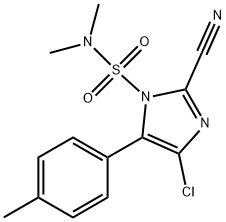120116-88-3

Product Name:
CYAZOFAMID
Formula:
C13H13ClN4O2S
Synonyms:
4-Chloro-1-(dimethylaminosulfonyl)-5-(p-tolyl)imidazole-2-carbonitrile
Inquiry
CHEMICAL AND PHYSICAL PROPERTIES
| Physical Description | Ivory odorless solid; [Merck Index] |
|---|---|
| Color/Form | Ivory powder |
| Odor | Odorless |
| Melting Point | 152.7 °C |
| Solubility | Solvent solubility (all in g/100 mL, 21.2 °C): hexane, 0.003; methanol, 0.174, acetonitrile, 3.095, dichloroethane, 10.212; toluene, 0.600, ethyl acetate, 1.649; acetone, 4.564, octanol, 0.004 |
| Density | 1.446 at 20 °C |
| Vapor Pressure | 1.3X10-2 mPa /9.75X10-8 mm Hg/ at 35 °C |
| LogP | log Kow = 3.2 |
| pH | pH = 4.9 at 25 °C |
| Dissociation Constants | No pKa evident in pH range 2-12 |
| Collision Cross Section | 166.69 Ų [M+H]+ [CCS Type: TW] |
| Kovats Retention Index | 2388 |
| Chemical Classes | Pesticides -> Fungicides |
SAFETY INFORMATION
| Signal word | Warning |
|---|---|
| Pictogram(s) |
 Environment GHS09 |
| GHS Hazard Statements |
H410:Hazardous to the aquatic environment, long-term hazard |
| Precautionary Statement Codes |
P273:Avoid release to the environment. P391:Collect spillage. Hazardous to the aquatic environment P501:Dispose of contents/container to..… |
COMPUTED DESCRIPTORS
| Molecular Weight | 324.79 g/mol |
|---|---|
| XLogP3 | 2.6 |
| Hydrogen Bond Donor Count | 0 |
| Hydrogen Bond Acceptor Count | 5 |
| Rotatable Bond Count | 3 |
| Exact Mass | 324.0447745 g/mol |
| Monoisotopic Mass | 324.0447745 g/mol |
| Topological Polar Surface Area | 87.4 Ų |
| Heavy Atom Count | 21 |
| Formal Charge | 0 |
| Complexity | 516 |
| Isotope Atom Count | 0 |
| Defined Atom Stereocenter Count | 0 |
| Undefined Atom Stereocenter Count | 0 |
| Defined Bond Stereocenter Count | 0 |
| Undefined Bond Stereocenter Count | 0 |
| Covalently-Bonded Unit Count | 1 |
| Compound Is Canonicalized | Yes |
PRODUCT INTRODUCTION
description
Cyazofamid is a member of the class of imidazoles carrying dimethylsulfamyl, cyano, chloro and 4-tolyl substituents at positions 1, 2, 4 and 5 respectively. A fungicide used mainly for controlling Oomycete and Plasmodiophora diseases on potatoes and tomatoes. It is a skin and eye irritant and is moderately toxic to birds, most aquatic organisms, honeybees and earthworms. It has a role as a mitochondrial cytochrome-bc1 complex inhibitor and an antifungal agrochemical. It is a member of imidazoles, an organochlorine compound, a nitrile, a member of sulfamides, a sulfonamide fungicide and an imidazole fungicide.